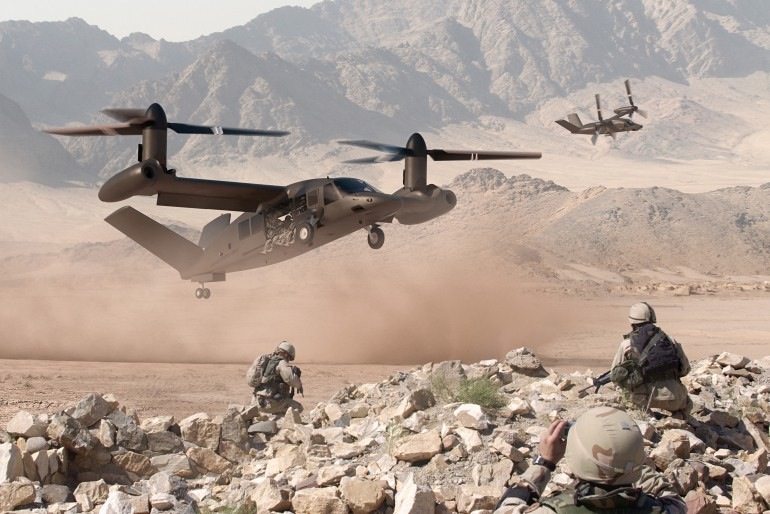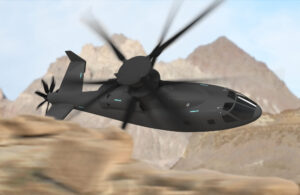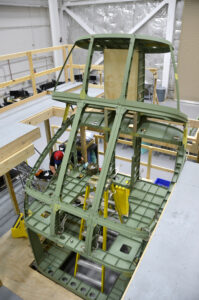V-280 Valor: Bell Starts Building Joint Multi-Role Prototype
Posted on
Somebody’s finally doing something tangible about the future of Army aviation. Bell Helicopter subcontractor Spirit AeroSystems of Wichita, Kan., has started assembling the composite fuselage for the first prototype V-280 Valor, Bell’s new military tiltrotor.
The Valor is sleeker, smaller, and, by design, more Army-friendly than the Bell-Boeing V-22 Osprey, which was built to fit on an amphibious assault ship for the Marines. Both aircraft are tilt rotors. Their wingtip rotors swivel upward to take off and land like a helicopter and tilt forward to fly fast and fuel-efficiently like an airplane.
For the moment, the Valor is just a technology demonstrator – a proposal, not a program – and only one of two the Pentagon is subsidizing in a quest to get beyond helicopters’ speed limitations and airplanes’ runway requirements. A few years down the road, the V-280 and its competitor could compete to replace the Army’s UH-60 Black Hawks and AH-64 Apaches with utility and attack aircraft of about 30,000 pounds that can fly faster than 230 knots – about 100 miles per hour faster than most military helicopters cruise — and hover like a hummingbird. Other armed services might want some, too.
The other tech demonstrator in the works is a compound helicopter offered by Sikorsky Aircraft Corp. and Boeing Co., dubbed — a bit cutely — the SB>1 Defiant, where “SB>1” means “Sikorsky and Boeing are greater than one.” Their entry is based on Sikorsky’s Collier Trophy-winning X2 technology demonstrator and derivative S-97 Raider. The Defiant, still in design, is to combine active vibration control, a rigid coaxial rotor and a variable RPM pusher propeller to overcome the speed limitations of helicopters.
Both the Valor and the Defiant are partially funded — at close to $100 million each, we hear — by the Army-led Joint Multi-Role Technology Demonstrator (JMRTD) project, which is in turn part of the far more comprehensive Future Vertical Lift (FVL) initiative. The FVL’s goal is to “move our vertical lift fleet into the next generation,” Program Director Dan Bailey told an American Helicopter Society International (AHS) briefing last month.
With lobbying help from AHS, Bailey got another $14 million from Congress last year to fund other companies to do smaller, related projects. A bit over half went to continue work on competing designs the Army decided not to build just yet when Bell and Sikorsky/Boeing got their JMR demonstrator contracts in October 2014. AVX Aircraft, a Texas design company, received $3.4 million to keep working on a coaxial helicopter with ducted fans for forward thrust. Karem Aircraft, a California company — whose founder, Abraham Karem, is the father of the Predator drone — got $4.1 million to hone a design using Karem’s patented Optimum Speed Tiltrotor technology.
Both the Bell and Sikorsky/Boeing demonstrators are to fly in 2017. Even if they succeed, there’s no guarantee of production. But with many current helicopters aging alarmingly, there’s got to be a replacement eventually.
“The tech demo is the key to understanding what the next generation of military rotorcraft could be for the rest of the century,” said AHS Executive Director Michael Hirschberg.
The JMRTD is just a first step toward the FVL’s goal of new military aircraft in four categories – light, medium, heavy, and ultra heavy — that can take off and land most anywhere and fly fast and far without costing a fortunate or being hangar queens. “It’s much more about learning than it is about specific products,” Bailey said.
Even so, with the V-280 fuselage actually being built, a bit of rotorcraft history is being made. The last time the Pentagon funded a pure vertical take-off-and-landing tech demonstrator was 1973, when after a similar lead up, the Army and NASA’s Ames Research Center awarded Bell a contract to build a small tiltrotor designated the XV-15.
Once they get the V-280 and SB>1 flying, Bell and Sikorsky/Boeing might hope history repeats itself, at least up to a point. After watching the XV-15 fly at the 1981 Paris Air Show, Navy Secretary John Lehman directed the Marine Corps to drop plans to replace its CH-46 Sea Knights with another helicopter and instead develop a tiltrotor. Thus was born the V-22. That once-derided tiltrotor is now in service with the Marines, Air Force Special Operations Command, and soon the Navy. Soon only the Army — which passed on the V-22 despite sponsoring the XV-15 — will still fly conventional helicopters exclusively. A primary goal for these new aircraft is to change that.
Subscribe to our newsletter
Promotions, new products and sales. Directly to your inbox.



